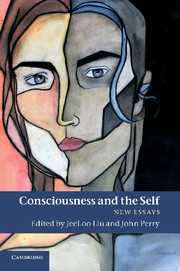Book contents
- Frontmatter
- Contents
- Acknowledgments
- Contributors
- Introduction
- Chapter 1 Awareness and identification of self
- Chapter 2 Self-representationalism and the explanatory gap
- Chapter 3 Thinking about the self
- Chapter 4 Ordinary self-consciousness
- Chapter 5 Waiting for the self
- Chapter 6 I think I think, therefore I am – I think
- Chapter 7 Knowing what I want
- Chapter 8 Self-ignorance
- Chapter 9 Personhood and consciousness
- Chapter 10 My non-narrative, non-forensic Dasein
- References
- Index
Chapter 1 - Awareness and identification of self
Published online by Cambridge University Press: 05 December 2011
- Frontmatter
- Contents
- Acknowledgments
- Contributors
- Introduction
- Chapter 1 Awareness and identification of self
- Chapter 2 Self-representationalism and the explanatory gap
- Chapter 3 Thinking about the self
- Chapter 4 Ordinary self-consciousness
- Chapter 5 Waiting for the self
- Chapter 6 I think I think, therefore I am – I think
- Chapter 7 Knowing what I want
- Chapter 8 Self-ignorance
- Chapter 9 Personhood and consciousness
- Chapter 10 My non-narrative, non-forensic Dasein
- References
- Index
Summary
Self-awareness and the self
It is a crucial aspect of everyday mental functioning that we are in some way aware of ourselves. But it is far from clear at first sight just what this self-awareness consists in, and indeed just what the self is that we are aware of.
It is possible to give an answer to the second question that is mundane and unproblematic. The self one is aware of in everyday life is simply the individual that walks, talks, sleeps, and eats; the self one is aware of is, to echo Aristotle’s provisional definition of the soul, the living, functioning creature.
- Type
- Chapter
- Information
- Consciousness and the SelfNew Essays, pp. 22 - 50Publisher: Cambridge University PressPrint publication year: 2011
- 9
- Cited by

